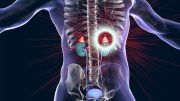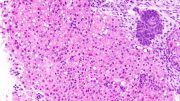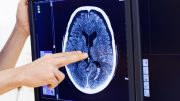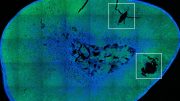
A recently discovered gene variant, found in benign nodules in 5% of people with hypertension, leads to an overproduction of the hormone aldosterone, causing high blood pressure. The condition can be cured through unilateral adrenalectomy, removing one adrenal gland. The study highlights the need for a 24-hour urine test to measure aldosterone levels for improved hypertension diagnosis and treatment.
Clinicians at Queen Mary University of London and Barts Hospital have identified a gene variant that causes a common type of hypertension (high blood pressure) and a way to cure it, new research published in the journal Nature Genetics shows.
The cause is a tiny benign nodule, present in one-in-twenty people with hypertension. The nodule produces a hormone, aldosterone, that controls how much salt is in the body. The new discovery is a gene variant in some of these nodules which leads to a vast, but intermittent, over-production of the hormone.
The gene variant discovered today causes several problems which makes it hard for doctors to diagnose some patients with hypertension. Firstly, the variant affects a protein called CADM1 and stops cells in the body from ‘talking’ to each other and saying that it is time to stop making aldosterone. The fluctuating release of aldosterone throughout the day is also an issue for doctors, which at its peak causes salt overload and hypertension. This fluctuation explains why patients with the gene variant can elude diagnosis unless they happen to have blood tests at different times of day.
Aldosterone is a type of mineralocorticoid hormone produced by the adrenal cortex, the outer layer of the adrenal gland. It plays a crucial role in maintaining the body’s water and salt balance by promoting sodium retention and potassium excretion in the kidneys. However, an excess of aldosterone can lead to hypertension, or high blood pressure, and fluid accumulation in body tissues.
The researchers also discovered that this form of hypertension could be cured by unilateral adrenalectomy – removing one of the two adrenal glands. Following removal, previously severe hypertension despite treatment with multiple drugs disappeared, with no treatment required through many subsequent years of observation.
Fewer than 1% of people with hypertension caused by aldosterone are identified because aldosterone is not routinely measured as a possible cause. The researchers are recommending that aldosterone is measured through a 24-hour urine test rather than one-off blood measurements, which will discover more people living with hypertension but going undiagnosed.
The initial patient in this study was detected when doctors noticed fluctuation in his hormone levels during his participation in a clinical trial of treatments for difficult hypertension.
In most people with hypertension, the cause is unknown, and the condition requires life-long treatment by drugs. Previous research by the group at Queen Mary discovered that in 5-10% of people with hypertension the cause is a gene mutation in the adrenal glands, which results in excessive amounts of aldosterone being produced. Aldosterone causes salt to be retained in the body, driving up the blood pressure. Patients with excessive aldosterone levels in the blood are resistant to treatment with the commonly used drugs for hypertension, and at increased risk of heart attacks and strokes.
Professor Morris Brown, co-senior author of the study and Professor of Endocrine Hypertension at Queen Mary University of London, said:
“In the 900th anniversary of Barts Hospital, this story illustrates benefits from the virtuous circle of Science and Medicine. Most patients consent to our undertaking non-routine molecular analyses of their surgical samples, from which we discover how their hypertension was caused, and how to cure it in future patients. Because the aldosterone nodules in this study were so small, we are now investigating whether momentary cauterization of the nodule is an alternative to surgical removal of the whole adrenal gland.”
Reference: “Somatic mutations of CADM1 in aldosterone-producing adenomas and gap junction-dependent regulation of aldosterone production” by Xilin Wu, Elena A. B. Azizan, Emily Goodchild, Sumedha Garg, Man Hagiyama, Claudia P. Cabrera, Fabio L. Fernandes-Rosa, Sheerazed Boulkroun, Jyn Ling Kuan, Zenia Tiang, Alessia David, Masanori Murakami, Charles A. Mein, Eva Wozniak, Wanfeng Zhao, Alison Marker, Folma Buss, Rebecca S. Saleeb, Jackie Salsbury, Yuta Tezuka, Fumitoshi Satoh, Kenji Oki, Aaron M. Udager, Debbie L. Cohen, Heather Wachtel, Peter J. King, William M. Drake, Mark Gurnell, Jiri Ceral, Ales Ryska, Muaatamarulain Mustangin, Yin Ping Wong, Geok Chin Tan, Miroslav Solar, Martin Reincke, William E. Rainey, Roger S. Foo, Yutaka Takaoka, Sandra A. Murray, Maria-Christina Zennaro, Felix Beuschlein, Akihiko Ito and Morris J. Brown, 8 June 2023, Nature Genetics.
DOI: 10.1038/s41588-023-01403-0
The research at Queen Mary was funded by Barts Charity and undertaken by research fellows funded by the British Heart Foundation, National Institute of Health Research, Medical Research Council and Royal Society. The team collaborated with laboratories in Munich, Paris and Michigan to find further people with the new variant, and in Osakasayama, Japan, KL, Malaysia, and Pittsburgh, USA, to better understand its effect on the body.









So how does a person get this issue fixed
Wow this sounds like a major breakthrough in the treatment of high blood pressure and early heart attack! As someone whose father died of this disease in his 40’s, I am so happy to hear about this! Congratulations!